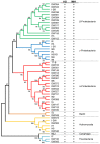Characterization of Two Novel Predatory Bacteria, Bacteriovorax stolpii HI3 and Myxococcus sp. MH1, Isolated from a Freshwater Pond: Prey Range, and Predatory Dynamics and Efficiency
- PMID: 36144418
- PMCID: PMC9505378
- DOI: 10.3390/microorganisms10091816
Characterization of Two Novel Predatory Bacteria, Bacteriovorax stolpii HI3 and Myxococcus sp. MH1, Isolated from a Freshwater Pond: Prey Range, and Predatory Dynamics and Efficiency
Abstract
Predatory bacteria, which prey on other bacteria, have significant functions in microbial ecosystems and have attracted increasing attention for their biotechnological use. However, knowledge of the characteristics of wild-type environmental predatory bacteria remains limited. This study isolated two predatory bacteria, Bacteriovorax stolpii HI3 and Myxococcus sp. MH1, from a freshwater pond and characterized their predation capabilities. Determination of the prey range using 53 potential prey strains, including 52 environmental strains, revealed that B. stolpii HI3 and Myxococcus sp. MH1 could prey on a wide spectrum of Gram-negative bacteria and a broader range of bacteria, irrespective of phylogeny, in accordance with the common characteristics of Bdellovibrio and like organisms and myxobacteria, respectively. Liquid culture assays also found that although predation by B. stolpii HI3 rapidly and largely occurred, the prey bacteria regrew, possibly through plastic phenotypic resistance to predation. In contrast, predation by Myxococcus sp. MH1 occurred at relatively low efficiency but was longer lasting. The two strains exhibited slightly distinct temperature preferences but commonly preferred slightly alkaline pH. The novel findings of this study provide evidence for the coexistence of predatory bacteria with diverse predation capabilities in the natural aquatic environment.
Keywords: Bacteriovorax; Myxococcus; freshwater pond; isolation; predation dynamics; predatory bacteria; prey range.
Conflict of interest statement
The authors declare no conflict of interest.
Figures





Similar articles
-
Complete Genome Sequences of Two Predatory Bacterial Strains, Bacteriovorax sp. HI3 and Myxococcus sp. MH1, Isolated from a Freshwater Pond.Microbiol Resour Announc. 2022 Dec 15;11(12):e0114622. doi: 10.1128/mra.01146-22. Epub 2022 Nov 21. Microbiol Resour Announc. 2022. PMID: 36409112 Free PMC article.
-
A proposal for the reclassification of Bdellovibrio stolpii and Bdellovibrio starrii into a new genus, Bacteriovorax gen. nov. as Bacteriovorax stolpii comb. nov. and Bacteriovorax starrii comb. nov., respectively.Int J Syst Evol Microbiol. 2000 Jan;50 Pt 1:219-224. doi: 10.1099/00207713-50-1-219. Int J Syst Evol Microbiol. 2000. PMID: 10826807
-
Phylogenetic relationships amongst the saltwater members of the genus Bacteriovorax using rpoB sequences and reclassification of Bacteriovorax stolpii as Bacteriolyticum stolpii gen. nov., comb. nov.Int J Syst Evol Microbiol. 2008 May;58(Pt 5):1203-9. doi: 10.1099/ijs.0.65710-0. Int J Syst Evol Microbiol. 2008. PMID: 18450714
-
The Genetics of Prey Susceptibility to Myxobacterial Predation: A Review, Including an Investigation into Pseudomonas aeruginosa Mutations Affecting Predation by Myxococcus xanthus.Microb Physiol. 2021;31(2):57-66. doi: 10.1159/000515546. Epub 2021 Apr 1. Microb Physiol. 2021. PMID: 33794538 Review.
-
Myxococcus xanthus predation: an updated overview.Front Microbiol. 2024 Jan 24;15:1339696. doi: 10.3389/fmicb.2024.1339696. eCollection 2024. Front Microbiol. 2024. PMID: 38328431 Free PMC article. Review.
Cited by
-
Predation on bacterial pathogens by predatory bacteria of sewage origin: three days prey-predator interactions.BMC Microbiol. 2024 Dec 4;24(1):516. doi: 10.1186/s12866-024-03672-z. BMC Microbiol. 2024. PMID: 39627702 Free PMC article.
-
Potential of Predatory Bacteria to Colonize the Duckweed Microbiome and Change Its Structure: A Model Study Using the Obligate Predatory Bacterium, Bacteriovorax sp. HI3.Microbes Environ. 2023;38(3):ME23040. doi: 10.1264/jsme2.ME23040. Microbes Environ. 2023. PMID: 37690850 Free PMC article.
-
Predatory Bacteria in the Treatment of Infectious Diseases and Beyond.Infect Dis Rep. 2024 Jul 25;16(4):684-698. doi: 10.3390/idr16040052. Infect Dis Rep. 2024. PMID: 39195003 Free PMC article. Review.
-
Complete Genome Sequences of Two Predatory Bacterial Strains, Bacteriovorax sp. HI3 and Myxococcus sp. MH1, Isolated from a Freshwater Pond.Microbiol Resour Announc. 2022 Dec 15;11(12):e0114622. doi: 10.1128/mra.01146-22. Epub 2022 Nov 21. Microbiol Resour Announc. 2022. PMID: 36409112 Free PMC article.
-
Chromosomal organization of biosynthetic gene clusters suggests plasticity of myxobacterial specialized metabolism including descriptions for nine novel species: Archangium lansinium sp. nov., Myxococcus landrumus sp. nov., Nannocystis bainbridgea sp. nov., Nannocystis poenicansa sp. nov., Nannocystis radixulma sp. nov., Polyangium mundeleinium sp. nov., Pyxidicoccus parkwaysis sp. nov., Sorangium aterium sp. nov., Stigmatella ashevillena sp. nov.bioRxiv [Preprint]. 2023 Mar 8:2023.03.08.531766. doi: 10.1101/2023.03.08.531766. bioRxiv. 2023. PMID: 36945379 Free PMC article. Preprint.
References
Grants and funding
LinkOut - more resources
Full Text Sources
Molecular Biology Databases

